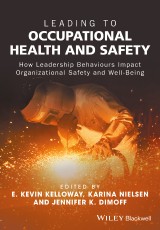Details

Leading to Occupational Health and Safety
How Leadership Behaviours Impact Organizational Safety and Well-Being1. Aufl.
|
37,99 € |
|
| Verlag: | Wiley-Blackwell |
| Format: | |
| Veröffentl.: | 25.01.2017 |
| ISBN/EAN: | 9781118973738 |
| Sprache: | englisch |
| Anzahl Seiten: | 344 |
DRM-geschütztes eBook, Sie benötigen z.B. Adobe Digital Editions und eine Adobe ID zum Lesen.
Beschreibungen
<p><i>Leading to Occupational Health and Safety</i> brings together prominent researchers to explore the pervasive roles that leaders play in determining the health, safety and mental well-being of employees in organizations.</p> <ul> <li>The first text to directly link organizational leadership behaviours with health and safety outcomes, covering theory, research and evidence-based best practice</li> <li>Argues that a leader’s impact can be far more far-reaching than is commonly realized, and examines the effects of leadership on safety, physical wellness and wellbeing, and psychological wellbeing</li> <li>Explores the theoretical underpinnings of effective leadership styles and behaviors, and advances both research and practice in order to encourage better leadership and healthier, safer organizations</li> <li>Features contributions from internationally known and respected researchers including Sharon Clarke, Kara Arnold, Fred Luthans, Ståle Einarsen, Julian Barling, and Emma Donaldson-Feilder</li> </ul>
<p>Notes on Contributors vii<br /><br />Introduction 1<br /><i>E. Kevin Kelloway, Karina Nielsen and Jennifer K. Dimoff</i></p> <p>1 Leadership and Safety: A Self-Regulation and Social Learning Perspective 9<br /><i>Sharon Clarke, Sara Guediri and Allan Lee</i></p> <p>2 Senior Management Safety Leadership Behaviour 33<br /><i>Kate C. Bowers, Mark Fleming and Andrea Bishop</i></p> <p>3 Developing Safety Leadership 49<br /><i>Jennifer Wong, Timur Ozbilir and Jane Mullen</i></p> <p>4 The Antecedents of Transformational Leadership and Its Consequences for Occupational Health and Safety 69<br /><i>Susanne Tafvelin</i></p> <p>5 Leading to a Respectful Workplace 93<br /><i>Annilee M. Game</i></p> <p>6 Leading the Psychologically Healthy Workplace: The RIGHT Way 113<br /><i>E. Kevin Kelloway, Samantha A. Penney and Jennifer K. Dimoff</i></p> <p>7 Leadership and Work–Family Conflict 129<br /><i>Ana Isabel Sanz-Vergel and Alfredo Rodríguez-Muñoz</i></p> <p>8 Leaders as Resources: How Managers and Supervisors Can Socially Support Employees Towards Better Mental Health and Well-Being 149<br /><i>Jennifer K. Dimoff and E. Kevin Kelloway</i></p> <p>9 Destructive Forms of Leadership and Their Relationships with Employee Well-Being 163<br /><i>Anders Skogstad, Morten Birkeland Nielsen and Ståle Einarsen</i></p> <p>10 Leaders Can Make or Break an Intervention – But Are They the Villains of the Piece? 197<br /><i>Karina Nielsen</i></p> <p>11 Developing Positive Leadership for Employee Well-Being and Engagement 211<br /><i>Emma Donaldson?-Feilder and Rachel Lewis</i></p> <p>12 Mindful Leadership and Employee Well-Being: The Mediating Role of Leader Behaviours 235<br /><i>Megan M. Walsh and Kara A. Arnold</i></p> <p>13 Leading and Developing Health and Safety through Collective Psychological Capital 255<br /><i>Julie Dyrdek Broad and Fred Luthans</i></p> <p>14 'Choose a Job You Love, and You Will Never Have to Work a Day in your Life': A Strengths-based Leadership Approach to Optimal Functioning at Work 281<br /><i>Philippe Dubreuil and Jacques Forest</i></p> <p>15 Leadership and Mental Illness: Realities and New Directions 307<br /><i>Erica L. Carleton and Julian Barling</i></p> <p>Index 323</p>
<p><b>E. Kevin Kelloway</b> is Professor of Psychology and Canada Research Chair in Occupational Health Psychology at Saint Mary's University, where he was Founding Director for the CN Centre for Occupational Health and Safety and a founding principal of the Centre for Leadership Excellence. He is a recipient of the Distinguished Psychologist in Management Award from the Society for Psychologists in Management, and currently serves as President of the Canadian Psychological Association. He has published widely and is an associate editor of <i>Work & Stress</i>, <i>The Journal of Occupational Psychology </i>and <i>The Journal of Organizational Effectiveness</i>.</p> <p><b>Karina Nielsen</b> is Professor of Work and Organisational Psychology at Norwich Business School, University of East Anglia, and a research affiliate at the CPH-NEW, US and Karolinska Institutet, Sweden. She has published more than 100 books chapters and articles. She is currently on the editorial boards of <i>Human Relations, The Leadership Quarterly, </i>and<i> Journal of Business and Psychology </i>and is an associate editor of <i>Work & Stress</i>.</p> <p><b>Jennifer K. Dimoff </b>is a doctoral candidate in Industrial/Organizational Psychology at Saint Mary's University, where she completed her master's degree in Applied Psychology. Her research interests include workplace mental health, leadership training, and psychological resilience. Her graduate work has focused primarily on the development and evaluation of manager-focused workplace mental health training programs.</p>
<p>Leaders play a pervasive role in determining the health and safety of organizations. They can influence safety, employee well-being, and available mental health resources. <i>Leading to Occupational Health and Safety</i> brings together the rapidly growing body of research on this topic, and translates it into clear principles for learning along with evidence-based guidance for practice. The book opens by considering the role of the leader in promoting or developing safe workplaces, before discussing the impact of leadership on employee health and wellbeing. Contributors then move beyond traditional divides to explore the many ways in which leadership and wellbeing are intertwined, focusing on new concepts that the authors integrate into existing literature. A final chapter considers the impact on organizations of the psychological wellbeing of leaders themselves.</p>

















